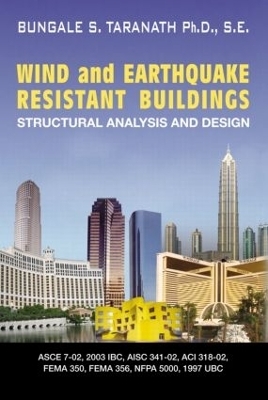
Wind and Earthquake Resistant Buildings
Structural Analysis and Design
Seiten
2004
Crc Press Inc (Verlag)
978-0-8247-5934-6 (ISBN)
Crc Press Inc (Verlag)
978-0-8247-5934-6 (ISBN)
Offers an understanding of the behavior of steel, concrete, and composite building structures. This book reviews wind effects and outlines seismic design, highlighting the dynamic behavior of buildings. It covers the design and detailing the requirements of steel, concrete, and composite buildings assigned to seismic design categories A through E.
Developed as a resource for practicing engineers, while simultaneously serving as a text in a formal classroom setting, Wind and Earthquake Resistant Buildings provides a fundmental understanding of the behavior of steel, concrete, and composite building structures. The text format follows, in a logical manner, the typical process of designing a building, from the first step of determining design loads, to the final step of evaluating its behavior for unusual effects.
Includes a worksheet that takes the drudgery out of estimating wind response.
The book presents an in-depth review of wind effects and outlines seismic design, highlighting the dymamic behavior of buildings. It covers the design and detailing the requirements of steel, concrete, and composite buidlings assigned to seismic design categories A through E. The author explains critical code specific items and structural concepts by doing the nearly impossible feat of addressing the history, reason for existence, and intent of major design provisions of the building codes. While the scope of the book is intentionally broad, it provides enough in-depth coverage to make it useful for structural engineers in all stages of their careers.
Developed as a resource for practicing engineers, while simultaneously serving as a text in a formal classroom setting, Wind and Earthquake Resistant Buildings provides a fundmental understanding of the behavior of steel, concrete, and composite building structures. The text format follows, in a logical manner, the typical process of designing a building, from the first step of determining design loads, to the final step of evaluating its behavior for unusual effects.
Includes a worksheet that takes the drudgery out of estimating wind response.
The book presents an in-depth review of wind effects and outlines seismic design, highlighting the dymamic behavior of buildings. It covers the design and detailing the requirements of steel, concrete, and composite buidlings assigned to seismic design categories A through E. The author explains critical code specific items and structural concepts by doing the nearly impossible feat of addressing the history, reason for existence, and intent of major design provisions of the building codes. While the scope of the book is intentionally broad, it provides enough in-depth coverage to make it useful for structural engineers in all stages of their careers.
Taranath, Bungale S.
Wind Loads. Seismic Design. Steel Buildings. Concrete Buildings. Composite Buildings. Seismic Rehabilitation of Existing Buildings. Gravity Systems. Special Topics. Index.
| Erscheint lt. Verlag | 15.12.2004 |
|---|---|
| Verlagsort | Bosa Roca |
| Sprache | englisch |
| Maße | 178 x 254 mm |
| Gewicht | 1837 g |
| Themenwelt | Technik ► Bauwesen |
| Technik ► Bergbau | |
| Technik ► Elektrotechnik / Energietechnik | |
| Technik ► Umwelttechnik / Biotechnologie | |
| ISBN-10 | 0-8247-5934-6 / 0824759346 |
| ISBN-13 | 978-0-8247-5934-6 / 9780824759346 |
| Zustand | Neuware |
| Haben Sie eine Frage zum Produkt? |
Mehr entdecken
aus dem Bereich
aus dem Bereich
Grundlagen und Vorgehensweisen
Buch | Softcover (2021)
Springer Fachmedien Wiesbaden GmbH (Verlag)
CHF 53,15
Bemessung von Stahlbauten nach Eurocode mit zahlreichen Beispielen
Buch | Hardcover (2024)
Springer Vieweg (Verlag)
CHF 83,95
Kommentar zu VOB/C ATV DIN 18340, ATV DIN 18299
Buch | Softcover (2024)
DIN Media (Verlag)
CHF 96,55


